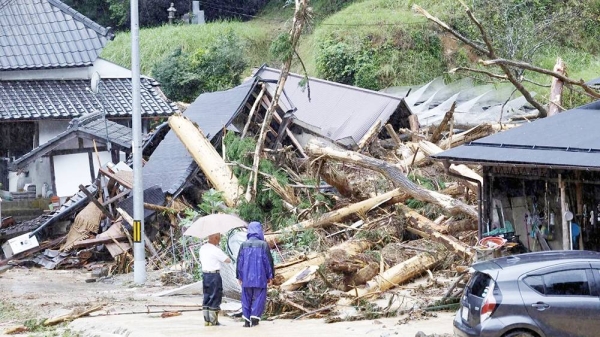
About half a million people in NSW are under evacuation orders or warnings as the wild weather system that has battered parts of eastern Australia for a week homes in on the greater Sydney region.
Steph Cooke, NSW’s emergency service minister, said the state had 76 evacuation orders in place, affecting 200,000 people with another 18 evacuation warnings covering about 300,000.
“We have 500,000 people in our state right now, who are either the subject of an evacuation warning or an evacuation,” Cooke said.
The evacuation orders cover areas of northern NSW and also parts of the greater Sydney region and the Illawarra.
“We will be putting out more warnings and orders as the day goes on,” Carlene York, SES commissioner, told reporters.
The Bureau of Meteorology has issued multiple warnings for rivers to flood and for severe weather to affect a region of eastern NSW from near Taree, north of Newcastle down almost to Moruya Heads on the South Coast.
Flood warnings were in place for Hawkesbury-Nepean river near Sydney, that had prompted many of the evacuations overnight, but also for Wilsons, Richmond and Clarence rivers in northern NSW where there have been record floods.
The heavy rain and potential damaging winds and dangerous surf are the result of an east coast low that was located about 140km east of Newcastle as of 5am local time, Thursday. It was forecast by the bureau to deepen and continue moving towards the Hunter or southern Mid North Coast districts before weakening this evening.
Sydney’s forecast is for 100-150mm of rain with the chance of a thunderstorm, possibly severe.
“Heavy rainfall which may lead to flash flooding is forecast to develop over parts of the Hunter and Metropolitan, Illawarra and parts of South Coast, Southern Tablelands and Central Tablelands Forecast Districts during Thursday morning before starting to ease from Thursday evening,” the bureau said. “Six-hourly rainfall totals between 80 and 120 mm are likely.”
Where thunderstorms form, there is the risk of locally intense rainfall reaching as much as 200mm over six hours, leading to dangerous and life-threatening flash flooding, the bureau said.
Many schools are closed and the SES is encouraging people in affected areas to avoid all non-essential travel.
Rain fall since 9am Wednesday topped 100mm in areas of Sydney’s south, west and north-west, while the CBD collected about 50mm.
Warragamba Dam, Sydney’s main reservoir, began spilling early on Wednesday morning and by Thursday morning it was spilling at the rate of 300 gigalitres.
NSW deputy premier Paul Toole said the worst-case scenario was for the dam to spill at 600GL/day rate. That would be well above the 440-460GL/day peak rate during the March 2021 floods.
“Major flooding higher than the March 2021 event [is] possible” for the North Richmond, Windsor and towns downstream from Thursday into Friday, the bureau said.
The forecast offers little solace for many along the eastern seaboard, with lost more rain predicted for the coming week.
The SES said they had conducted 47 flood rescue overnight in western and southern Sydney, with most involving motorists who had driven into floodwaters.
Wild weather is also affecting Queensland this morning.
Ben Domensino, a senior meteorologist at Weatherzone, said the slow-moving system had continually exceeded forecasts for rainfall.
“This heavy rain has all been fed by an atmospheric river that’s just been dragging moisture across the Coral Sea in the Tasman Sea and directing it towards the east coast,” Domensino said. Similar big flooding events around the world have tapped in such patterns.
“And there is a climate change signal in atmospheric rivers, and that’s been one of the components of this event,” he said.












